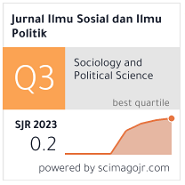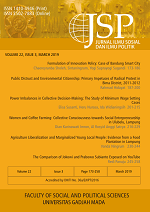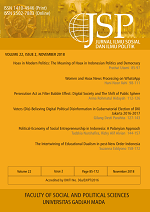Silent Political Apathy in Urban Society: The Case of Medan 2018 Election
Derajad Sulistyo Widhyharto(1*), Desi Rahmawati(2), Norin Mustika Rahadiri Abheseka(3)
(1) Departemen of Sosiology, Faculty of Social and Political Sciences, Universitas Gadjah Mada, Indonesia
(2) Research Centre for Politics and Government (PolGov), Faculty of Social and Political Sciences, Universitas Gadjah Mada, Indonesia
(3) Research Centre for Politics and Government (PolGov), Faculty of Social and Political Sciences, Universitas Gadjah Mada, Indonesia
(*) Corresponding Author
Abstract
Studies on non-voting behavior and which depart from social perspectives have long been stagnated due to the dominance of analysis that puts systems, institutionalization, political mechanisms and participation as the main viewpoints of the studies. This study using social perspectives is useful to explain why voters were not present at polling stations during the Medan 2018 Election. It elaborates the social aspects that influenced non-voting behavior in the urban area of Medan in North Sumatra, Indonesia during the 2018 gubernatorial election. Utilizing mix- method strategies, instead of citing social aspects as a mere research context, this article argues that social aspects in the form of social cleavages worked behind the silent apathy, namely apathy that was implicitly indicated by voters who were not present at polling stations. Social cleavages including ethnicity, religion and gender indicated a paradox since they—with the exception of gender—were used by candidates as the main campaign substance. On the other hand, large numbers of people showed disinterest in these social cleavages during the election. This article explains why abstained voters hid their disinterest behind their excuses for not being present at the polling stations for economic (working activities) and other reasons.
Keywords
Full Text:
PDFReferences
Abendschon, S., & Steinmetz, S. (2014). The Gender Gap in Voting Revisited: Women’s Party Preferences in a European Context. Social Politics: International Studies in Gender, State & Society, 21(2), 315–344. https://doi.org/10.1093/sp/jxu009
Achterberg, P. (2006). Class Voting in the New Political Culture. Internati ona l Sociology, 21(2), 237–261. https://doi. org/10.1177/0268580906061378
Adams, J., Dow, J., & Merrill, S. (2006). The political consequences of alienation-based and indifference-based voter abstention: Applications to Presidential Elections. Political Behavior, 28(1), 65–86. https://doi. org/10.1007/s11109-005-9002-1
Amin, M. (2014). Relasi Jaringan Organisasi Pemuda dalam Pemilihan Gubernur Sumatera Utara. Jurnal Komunitas, 6(1), 151–158. https://doi.org/10.15294/komunitas.v6i1.2951
Blais, A., & Aarts, K. (2006). Electoral Systems and Turnout. Acta Politica, 41(2), 180–196. https://doi.org/10.1057/palgrave. ap.5500148
Budi, A., Widhyharto, D. S., Rahmawati, D., Imawan, A. P., & Abheseka, N. M. R. (2018). Voters Abstention dalam Pemilihan Kepala Daerah: Studi Kasus Ketidakhadiran Pemilih dalam Pilkada 2018 di Kota Medan. Unpublished Manuscript.
Budi, A., Widhyharto, D. S., Rahmawati, D., Imawan, A. P., & Abheseka, N. M. R. (2020). Voters Abstention di Indonesia: Ketidakhadiran Pemilih di Kota Medan (Upcoming). Yogyakarta: Penerbit PolGov.
BPS (2018), Kota Medan Dalam Angka, Medan: Badan Pusat Statistik.
Christie, B. E. (2013). Pemukiman Etnis Cina di Medan Pada Akhir Abad Ke-19 Sampai Awal Abad ke 20. Unpublished theris. Universitas Indonesia.
Dalton, R. J. (2010). Ideology, partisanship, and democratic development. In Comparing Democracies: Elections and Voting in the 21st Century. https://doi. org/10.4135/9781446288740.n7
Damanik, E. L. (2018a). Whatsapp dan Pemilih Pemula di Kota Medan : Partisipasi Politik Era Demokrasi Digital pada Pemilihan Gubernur Provinsi Sumatera Utara 2018. The Journal of Society&Media, 2(2), 81–108.
Damanik, E. L. (2018b). Politik Lokal: Dinamika Etnisitas Pada Era Desentralisasi di Sumatera Utara. Medan: Simetri Institute.
Dean, D. G. (1965). Powerlessness and Political Apathy. Social Science, 40(4), 208–213.
DeLuca, T (1995), The Two Faces of Political Apathy. Philadelphia, PA: Temple University Press.
Delwit, P. (2013). The End of Voters in Europe? Electoral Turnout in Europe since WWII. Open Journal of Political Science, 03(01), 44–52. https://doi.org/10.4236/ojps.2013.31007
Downs, A. (1957). An Economic Theory of Political Action in a Democracy. Journal of Political Economy, 65(2), 135–150. https:// doi.org/10.1086/257897
Elff, M. (2007). Social Structure and Electoral Behavior in Comparative Perspective: The Decline of Social Cleavages in Western Europe Revisited. Perspectives on Politics, 5(02), 277–294. https://doi.org/10.1017/ S1537592707070788
Evans, J. A. J. (2003). Voters& Voting: An Introduction. In Sage Publication. https:// doi.org/10.4135/9781446216798
Faraidiany, M. (2016). Politik Identitas Etnis Tionghoa di Kota Medan. Politeia: Jurnal Ilmu Politik, 8(2), 74–82.
Feith, H. (2007). The Decline of Constitutional Democracy in Indonesia. Retrieved from https://books.google.co.id/books?id=VA H0W9uxoqoC&printsec=frontcover&hl= id&source=gbs_ge_summary_r&cad=0# v=onepage&q&f=false
Fieldhouse, E., Tranmer, M., & Russell, A. (2007). Something Ab out Young People or Something About Elections? Electoral Participation of Young People in Europe: Evidence From a Multilevel Analysis of The European Social Survey. European Journal of Political Research, 46(6), 797–822. https://doi.org/10.1111/j.1475-6765.2007.00713.x
Freixas, J., & Zwicker, W. S. (2003). Weighted voting, abstention, and multiple levels of approval. Social Choice and Welfare, 21(3), 399–431. https://doi.org/10.1007/s00355-003-0212-3
Greene, J. C., Caracelli, V. J., & Graham, W. F. (1989). T oward a Conceptual Framework for Mixed-Method Evaluation Designs. Educational Evaluation and Policy Analysis, 11(3), 255–274. https://doi. org/10.3102/01623737011003255
Halim, A. (2014). Politik Lokal. Medan: Simetri Institute.
Henn, M., Weinstein, M., & Forrest, S. (2005). Uninterested Youth? Young People’s Attitudes towards Party Politics in Britain. Political Studies, 53(3), 556–578. https://doi. org/10.1111/j.1467-9248.2005.00544.x
Hering, B. B., & Feith, H. (1963). The Decline of Constitutional Democracy in Indonesia. International Journal. https://doi.org/10.2307/40198726
Hesse-Biber, S. (2010). Qualitative Approaches to Mixed Methods Practice. Qualitative Inquiry, 16(6), 455–468. https://d o i. org/10.1177/1077800410364611
Higashikata, T., & Kawamura, K. (2015). Voting Behavior in Indonesia from 1999 to 2014: Religious Cleavage or Economic Performance? In SSRN Electronic Journal (No. 512). https://doi.org/10.2139/ssrn.2620455
Inglehart, R., & Norris, P. (2000). The Developmental Theory of the Gender Gap: Women’s and Men’s Voting Behavior in Global Perspective. International Political Science Review, 21(4), 441–463. https://doi.org/10.1177/0192512100214007
Jansen, G., De Graaf, N. D., & Need, A. (2011). Class Voting, Social Changes and Political Changes in The Netherlands 1971–2006. Electoral Studies, 30(3), 510–524. https:// doi.org/10.1016/j.electstud.2011.02.005
Jelen, T. G., Thomas, S., & Wilcox, C. (1994). The Gender Gap in Comparative Perspective. European Journal of Political Research, 25(2), 171–186. https://doi. org/10.1111/j.1475-6765.1994.tb00416.x
Kang, W.-T. (2004). Protest Vot ing and Abstention Under Plurality Rule Elections. Journal of Theoretical Politics, 16(1), 79–102. https://doi.org/10.1177/0951629804038903
Lipset, S. M., & Rokkan, S. (1967). Cleavage Structures, Party Systems, and Voter Alignments: An Introduction. In Party systems and voter alignments : cross-national perspectives. Free Press.
Martin, A. (2012). Political Participation among the Young in Australia: Testing Dalton’s Good Citizen Thesis. Australian Journal of Political Science, 47(2), 211–226. https://doi. org/10.1080/10361146.2012.677003
McClurg, S. D., Wade, M. L., & Philips, M. V. W. (2012). Gender, Social Networks, and Voting Behavior. In Political Networks Paper Archive (No. 64). Retrieved from http://opensiuc.lib.siu.edu/pn_wp/64/
Mukmin, B. A., & Damanik, M. R. S. (2018). D em o gra fi Po litik S um a ter a U tara : Analisis Pilihan Politik Masyarakat Berd as arkan Pers ebaran Pend uduk, A gam a d a n E tni s D a la m Pe m i li ha n Gubernur Sumatera Utara Tahun 2018 di Kota Medan. Jurnal Geografi, 10(2), 129–144. https://doi.org/10.24114/jg.v10i2.10532
Onwuegbuzie, A. ., & Collins, K.. (2007). A Typology of Mixed Methods Sampling Designs in Social Science Research. In The Qualitative Report (Vol. 12). Retrieved from https://nsuworks.nova.edu/tqr/ vol12/iss2/9/
Panggabean, E. S. (2017). Religion, Socio-Economic Status and Voter Behavior: Evidence from a Survey Experiment in Jakarta. Retrieved from http://hdl.handle.net/2105/41631
Pierides, C. (2009). Changing Social Cleavages and the formation of Electoral Behaviour in Greece of the late“ Metapolitefsis ” (1996-1997). Athens.
Power, T. J., & Roberts, J. T. (1995). Compulsory Voting, Invalid Ballots, and Abstention in Brazil. Political Research Quarterly, 48(4), 795–826. https://doi. org/10.1177/106591299504800407
Rahmawati, D., Prasetyo, W., & Marantika, E. M. (2019). Crossing Primordial Division in Post Conflict Society: Ambon, Peran Jaringan Personal Non-Prim ordial Kandidat Perempuan dalam Kontestasi Electoral di Pemilu 2019 di Ambon. Unpublished Manuscript.
Reid, A. (2014). The Blood of the People. https://doi.org/10.2307/j.ctv1qv3jz
Runciman, C. (2016). The ‘Ballot and The Brick’: Protest, Voting and Non-Voting in Post-Apartheid South Africa. Journal of Contemporary African Studies, 34(4), 419–436. https://doi.org/10.1080/02589001.2017.1287347
Ryter, L. (2001). Pemuda Pancasila: The Last Loyalist Free Men of Suharto’s Order? In B. R. O. Anderson (Ed.), Violence and the State in Suharto’s Indonesia (pp. 124–155). https://doi.org/10.7591/9781501719042-
Sternheimer, K. (2012). Rethinking Goffman’s Front Stage/Back Stage. Retrieved from Everyday Sociology website: https://www. everydaysociologyblog.com/2012/05/ rethinking-goffmans-front-stageback- stage.html
Stoler, A. L. (2005). Kapitalisme dan Konfrontasi di Sabuk Perkebunan Sumatera 1870-1979. Yogyakarta: Karsa.
Thomas, R. M. (1988). The Islamic revival and Indonesian education. Asian Survey, 28(9), 897-915. doi.org/10.2307/2644797
Trihartono, A., & Patriadi, H. B. (2016). The 2014 Indonesian General Election and Beyond: Melting “Frozen” Cleavages. Asian Journal of Comparative Politics, 1(1), 25–43. https:// doi.org/10.1177/2057891115620699
Windber, M. R. (2020), Political apathy and voting in the United States. Retrieved from Dailyamerican.com, https://www.dailyamerican.com/entertainment/highschoolhighlights/political-apathy-and-voting-in-the-united-states/article_0de30274-13d4-11eb-89ab-97ed3b90b672.html.
Article Metrics
Refbacks
- There are currently no refbacks.
Copyright (c) 2021 Jurnal Ilmu Sosial dan Ilmu Politik

This work is licensed under a Creative Commons Attribution-NonCommercial-NoDerivatives 4.0 International License.






















